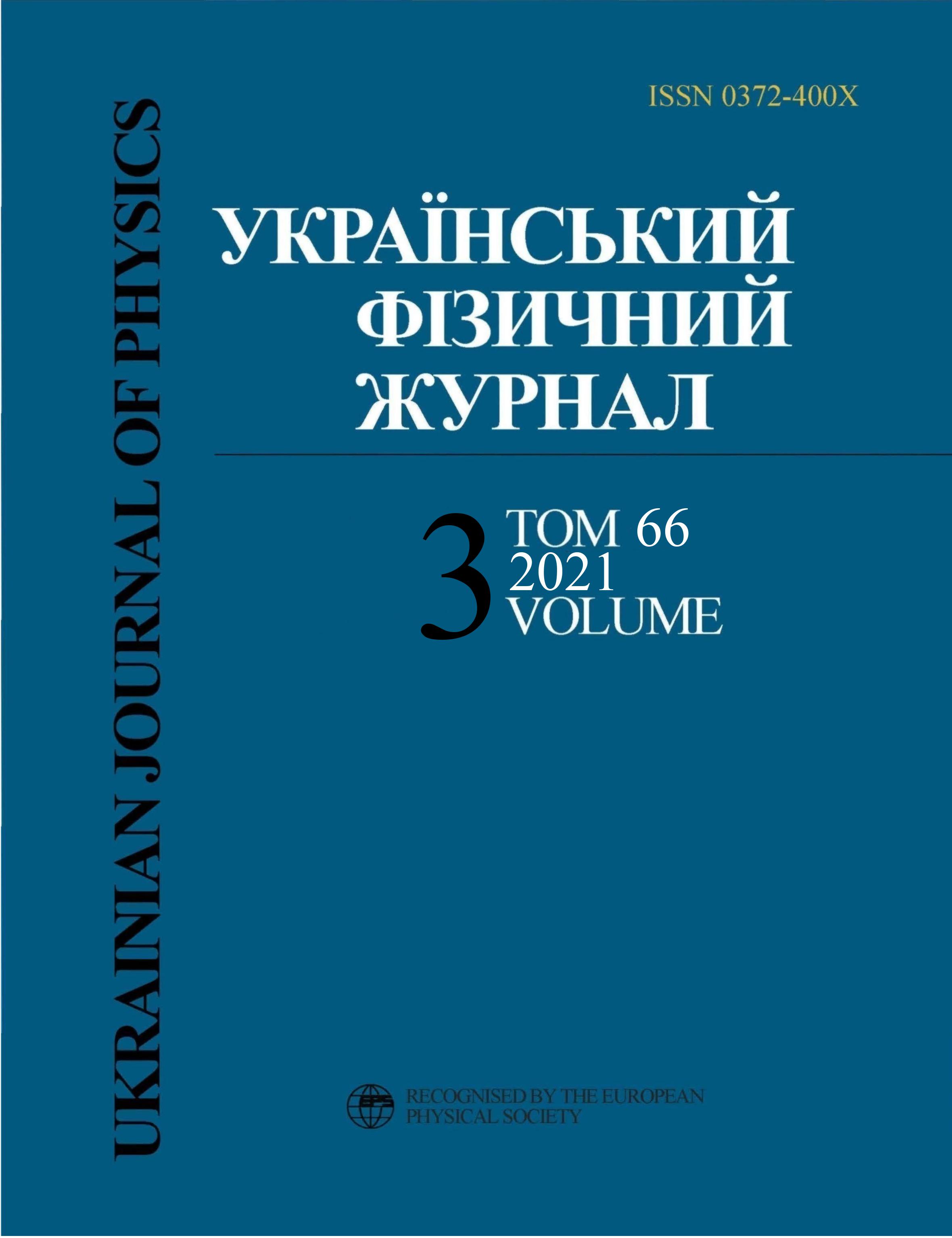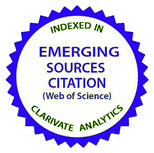Специфічна дія мікрохвиль на водний розчин родаміну 6G за даними флуоресцентного аналізу
DOI:
https://doi.org/10.15407/ujpe66.3.265Ключові слова:
мiкрохвильове нагрiвання, флуоресценцiя, органiчний барвник, перколяцiйна модельАнотація
Вивчено вплив мiкрохвиль з частотою 2,45 ГГц на флуоресценцiю водного розчину органiчного барвника родамiну 6G. Зафiксовано вiдхилення в динамiцi змiни вiдносної iнтенсивностi та пiкової довжини хвилi пiд час поглинання мiкрохвиль, а також пiд час подальшого охолодження розчину порiвняно iз контактним нагрiванням. Результати iнтерпретовано в рамках перколяцiйної моделi. Передбачається, що електрична складова електромагнiтної хвилi може безпосередньо впливати на структуру перколяцiйного кластера, який формується сiткою водневих зв’язкiв.
Посилання
A. Bekal, A.M. Hebbale, M. Srinath. Review on material processing through microwave energy. IOP Conf. Ser.: Mater. Sci. Eng. 376, 012079 (2018).
https://doi.org/10.1088/1757-899X/376/1/012079
R. Walczak, J. Dziuban. "Microwave memory effect" of activated water and aqueous KOH solution. In: Proceedings of the 15th International Conference on Microwaves, Radar and Wireless Communications, 17-19 May 2004, Warsaw (IEEE, 2004).
A. Copty, Y. Neve-Oz, I. Barak, M. Golosovsky, D. Davidov. Evidence for a specific microwave radiation effect on the green fluorescent protein. Biophys. J. 91, 1413 (2006).
https://doi.org/10.1529/biophysj.106.084111
Huang Kama, Xiaoqing Yang, Wei Hua, Guozhu Jia, Lijun Yang. Experimental evidence of a microwave non-thermal effect in electrolyte aqueous solutions. New J. Chem. 33, 1486 (2009).
https://doi.org/10.1039/b821970b
G. Morariu, M. Miron, A.-M. Mita, L.-V. Stan. Microwaves electromagnetic field influence on pH. Theoretical and experimental results. Rev. Air Force Acad. No. 1, 45 (2009).
H. Parmar, A. Masahiro, K. Yushin, A. Yusuke, Ph. Chi, P. Vishnu, E. Geoffrey. Influence of microwaves on the water surface tension. Langmuir 30, 9875 (2014).
https://doi.org/10.1021/la5019218
A. Yakunov, M. Biliy, A. Naumenko. Long-term structural modification of water under microwave irradiation: Low-
frequency Raman spectroscopic measurements. Adv. Opt. Technol. 2017, 1 (2017).
https://doi.org/10.1155/2017/5260912
J. Jacob, L. Chia, F. Boey. Thermal and non-thermal interaction of microwave radiation with materials. J. Mater. Sci. 30, 5321 (1995).
https://doi.org/10.1007/BF00351541
D. Stuerga, P. Gaillard. Microwave athermal effects in chemistry: A myth's autopsy: Part I: Historical background
and fundamentals of wave-matter interaction. J. Microw. Power Electromagn. Ener. 31, 87 (1996).
https://doi.org/10.1080/08327823.1996.11688299
N. Kuhnert. Microwave-assisted reactions in organic synthesis: Are there any nonthermal microwave effects? Angew. Chem. Int. Ed. 41, 1863 (2002).
https://doi.org/10.1002/1521-3773(20020603)41:11<1863::AID-ANIE1863>3.0.CO;2-L
C. Kappe, B. Pieber, D. Dallinger. Microwave effects in organic synthesis: Myth or reality? Angew. Chem. Int. Ed. 52, 1088 (2013).
https://doi.org/10.1002/anie.201204103
Boon Wong. Understanding nonthermal microwave effects in materials processing - A classical non-quantum approach. In: Processing and Properties of Advanced Ceramics and Composites VI: Ceramic Transactions, Vol. 249 (The American Ceramic Society, 2014), p. 329.
https://doi.org/10.1002/9781118995433.ch32
P. Bana, I. Greiner. Interpretation of the effects of microwaves. In Milestones in Microwave Chemistry (Springer, 2016), Ch. 4.
https://doi.org/10.1007/978-3-319-30632-2_4
J. Lou, T.M. Finegan, P. Mohsen, T.A. Hatton, P.E. Laibinis. Fluorescence-based thermometry: Principles and applications. Rev. Analyt. Chem. 18, 235 (1999).
https://doi.org/10.1515/REVAC.1999.18.4.235
L. Levshin, A. Saletskii, V. Yuzhakov. Forms of aggregation of molecules of rhodamine dyes in mixtures of polar and nonpolar solvents. Zh. Strukt. Khim. 26, 95 (1985) (in Russian).
https://doi.org/10.1007/BF00748362
A. Vasylieva, I. Doroshenko, Ye. Vaskivskyi, Ye. Chernolevska, V. Pogorelov. FTIR study of condensed water structure. J. Mol. Struct. 1167, 232 (2018).
https://doi.org/10.1016/j.molstruc.2018.05.002
N. Kuzkova, O. Popenko, A. Yakunov. Application of temperature-dependent fluorescent dyes to the measurement of millimeter wave absorption in water applied to biomedical experiments. J. Biomed. Imag. 2014, 1 (2014).
https://doi.org/10.1155/2014/243564
D. Babich, A. Kulsky, V. Pobiedina, A. Yakunov. Application of fluorescent dyes for some problems of bioelectromagnetics. In: Proc. SPIE 9887, Biophotonics: Photonic Solutions for Better Health Care V 9887, 988735 (2016).
https://doi.org/10.1117/12.2227373
J.R. Lakowicz. Principles of Fluorescence Spectroscopy (Springer, 2006).
https://doi.org/10.1007/978-0-387-46312-4
V. Degoda, A. Gumenyuk, I. Zakharchenko, O. Svechnikova. The features of the hyperbolic law of phosphorescence. J. Phys. Stud. 15, 1 (2011).
https://doi.org/10.30970/jps.15.3301
S. Viznyuk, P. Pashinin. The effect of temperature combustion luminescence in water solution of rhodamine 6G. JETP Lett. 47, 190 (1988).
K. Kristinaityte, A. Marsalka, L. Dagys, K. Aidas, I. Doroshenko, Y. Vaskivskyi, Y. Chernolevska, V. Pogorelov, N.R. Valeviciene, V. Balevicius. NMR, Raman, and DFT study of lyotropic chromonic liquid crystals of biomedical interest: Tautomeric equilibrium and slow self-assembling in sunset yellow aqueous solutions. J. Phys. Chem. B 122, 3047 (2018).
https://doi.org/10.1021/acs.jpcb.8b00350
L. Bulavin, M. Biliy, A. Maksymov, A. Yakunov. Peculiarities of the low-frequency Raman scattering by supramolecular inhomogeneties of hydrogen-bonded liquids. Ukr. J. Phys. 55, 966 (2010).
N. Kuzkova, A. Yakunov, M. Bilyi. Low-frequency Raman spectroscopic monitoring of supramolecular structure in H-bonded liquids. Adv. Opt. Technol. 2014, 1 (2014).
https://doi.org/10.1155/2014/798632
A. Yakunov, P. Yakunov. Slow dynamics of water structure in cellular automata model. In: Proceedings of the International Conference "Physics of Liquid Matter: Modern Problems" (2004), p. 140.
H. Hinrikus, M. Bachmann. J. Lass. Understanding physical mechanism of low-level microwave radiation effect. Int. J. Radiat. Biol. 94, 877 (2018).
https://doi.org/10.1080/09553002.2018.1478158
N. Domnina, A. Korolev, A. Potapov, A. Saletskii. Influence of microwave radiation on the association processes
of rhodamine 6G molecules in aqueous solutions. J. Appl. Spectrosc. 72, 33 (2005).
https://doi.org/10.1007/s10812-005-0027-3
V. Pogorelov, I. Doroshenko, G. Pitsevich, V. Balevicius, V. Sablinskas, B. Krivenko. L.G.M. Pettersson. From clusters to condensed phase-FT IR studies of water. J. Mol. Liq. 235, 7 (2017).
Downloads
Опубліковано
Як цитувати
Номер
Розділ
Ліцензія
Ліцензійний Договір
на використання Твору
м. Київ, Україна
Відповідальний автор та співавтори (надалі іменовані як Автор(и)) статті, яку він (вони) подають до Українського фізичного журналу, (надалі іменована як Твір) з одного боку та Інститут теоретичної фізики імені М.М. Боголюбова НАН України в особі директора (надалі – Видавець) з іншого боку уклали даний Договір про таке:
1. Предмет договору.
Автор(и) надає(ють) Видавцю безоплатно невиключні права на використання Твору (наукового, технічного або іншого характеру) на умовах, визначених цим Договором.
2. Способи використання Твору.
2.1. Автор(и) надає(ють) Видавцю право на використання Твору таким чином:
2.1.1. Використовувати Твір шляхом його видання в Українському фізичному журналі (далі – Видання) мовою оригіналу та в перекладі на англійську (погоджений Автором(ами) і Видавцем примірник Твору, прийнятого до друку, є невід’ємною частиною Ліцензійного договору).
2.1.2. Переробляти, адаптувати або іншим чином змінювати Твір за погодженням з Автором(ами).
2.1.3. Перекладати Твір у випадку, коли Твір викладений іншою мовою, ніж мова, якою передбачена публікація у Виданні.
2.2. Якщо Автор(и) виявить(лять) бажання використовувати Твір в інший спосіб, як то публікувати перекладену версію Твору (окрім випадку, зазначеного в п. 2.1.3 цього Договору); розміщувати повністю або частково в мережі Інтернет; публікувати Твір в інших, у тому числі іноземних, виданнях; включати Твір як складову частину інших збірників, антологій, енциклопедій тощо, то Автор(и) мають отримати на це письмовий дозвіл від Видавця.
3. Територія використання.
Автор(и) надає(ють) Видавцю право на використання Твору способами, зазначеними у п.п. 2.1.1–2.1.3 цього Договору, на території України, а також право на розповсюдження Твору як невід’ємної складової частини Видання на території України та інших країн шляхом передплати, продажу та безоплатної передачі третій стороні.
4. Строк, на який надаються права.
4.1. Договір є чинним з дати підписання та діє протягом усього часу функціонування Видання.
5. Застереження.
5.1. Автор(и) заявляє(ють), що:
– він/вона є автором (співавтором) Твору;
– авторські права на даний Твір не передані іншій стороні;
– даний Твір не був раніше опублікований і не буде опублікований у будь-якому іншому виданні до публікації його Видавцем (див. також п. 2.2);
– Автор(и) не порушив(ли) права інтелектуальної власності інших осіб. Якщо у Творі наведені матеріали інших осіб за виключенням випадків цитування в обсязі, виправданому науковим, інформаційним або критичним характером Твору, використання таких матеріалів здійснене Автором(ами) з дотриманням норм міжнародного законодавства і законодавства України.
6. Реквізити і підписи сторін.
Видавець: Інститут теоретичної фізики імені М.М. Боголюбова НАН України.
Адреса: м. Київ, вул. Метрологічна 14-б.
Автор: Електронний підпис від імені та за погодження всіх співавторів.

















